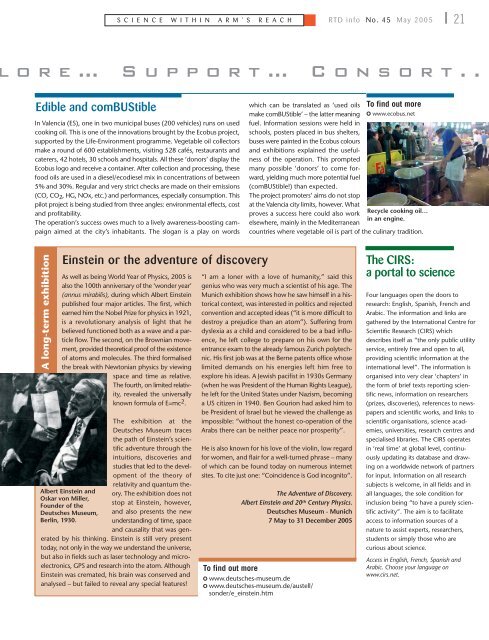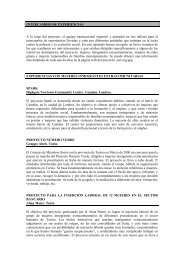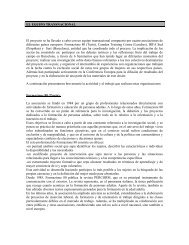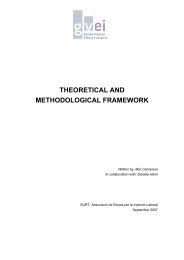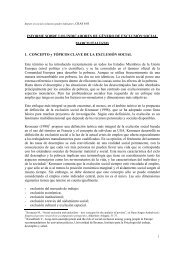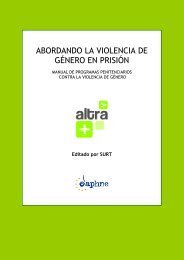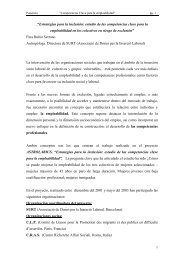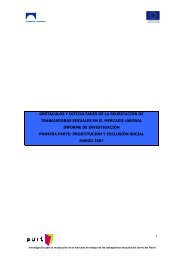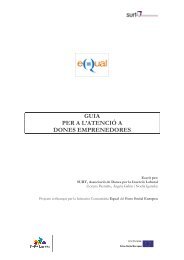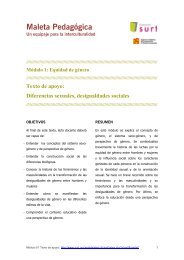RTD info MAYO 2005 - Surt
RTD info MAYO 2005 - Surt
RTD info MAYO 2005 - Surt
Create successful ePaper yourself
Turn your PDF publications into a flip-book with our unique Google optimized e-Paper software.
S C I E N C E W I T H I N A R M ’ S R E A C H <strong>RTD</strong> <strong>info</strong> No. 45 May <strong>2005</strong> 21ore… Support… Consort..Edible and comBUStibleIn Valencia (ES), one in two municipal buses (200 vehicles) runs on usedcooking oil. This is one of the innovations brought by the Ecobus project,supported by the Life-Environment programme. Vegetable oil collectorsmake a round of 600 establishments, visiting 528 cafés, restaurants andcaterers, 42 hotels, 30 schools and hospitals. All these ‘donors’ display theEcobus logo and receive a container. After collection and processing, thesefood oils are used in a diesel/ecodiesel mix in concentrations of between5% and 30%. Regular and very strict checks are made on their emissions(CO, CO 2 , HG, NOx, etc.) and performances, especially consumption. Thispilot project is being studied from three angles: environmental effects, costand profitability.The operation’s success owes much to a lively awareness-boosting campaignaimed at the city’s inhabitants. The slogan is a play on wordswhich can be translated as ‘used oils To find out moremake comBUStible’ – the latter meaning 0 www.ecobus.netfuel. Information sessions were held inschools, posters placed in bus shelters,buses were painted in the Ecobus coloursand exhibitions explained the usefulnessof the operation. This promptedmany possible ‘donors’ to come forward,yielding much more potential fuel(comBUStible!) than expected.The project promoters’ aims do not stopat the Valencia city limits, however. Whatproves a success here could also workRecycle cooking oil…in an engine.elsewhere, mainly in the Mediterraneancountries where vegetable oil is part of the culinary tradition.A long-term exhibitionEinstein or the adventure of discoveryAs well as being World Year of Physics, <strong>2005</strong> isalso the 100th anniversary of the ‘wonder year’(annus mirabilis), during which Albert Einsteinpublished four major articles. The first, whichearned him the Nobel Prize for physics in 1921,is a revolutionary analysis of light that hebelieved functioned both as a wave and a particleflow. The second, on the Brownian movement,provided theoretical proof of the existenceof atoms and molecules. The third formalisedthe break with Newtonian physics by viewingspace and time as relative.The fourth, on limited relativity,revealed the universallyknown formula of E=mc 2 .Albert Einstein andOskar von Miller,Founder of theDeutsches Museum,Berlin, 1930.The exhibition at theDeutsches Museum tracesthe path of Einstein’s scientificadventure through theintuitions, discoveries andstudies that led to the developmentof the theory ofrelativity and quantum theory.The exhibition does notstop at Einstein, however,and also presents the newunderstanding of time, spaceand causality that was generatedby his thinking. Einstein is still very presenttoday, not only in the way we understand the universe,but also in fields such as laser technology and microelectronics,GPS and research into the atom. AlthoughEinstein was cremated, his brain was conserved andanalysed – but failed to reveal any special features!“I am a loner with a love of humanity,” said thisgenius who was very much a scientist of his age. TheMunich exhibition shows how he saw himself in a historicalcontext, was interested in politics and rejectedconvention and accepted ideas (“it is more difficult todestroy a prejudice than an atom”). Suffering fromdyslexia as a child and considered to be a bad influence,he left college to prepare on his own for theentrance exam to the already famous Zurich polytechnic.His first job was at the Berne patents office whoselimited demands on his energies left him free toexplore his ideas. A Jewish pacifist in 1930s Germany(when he was President of the Human Rights League),he left for the United States under Nazism, becominga US citizen in 1940. Ben Gourion had asked him tobe President of Israel but he viewed the challenge asimpossible: “without the honest co-operation of theArabs there can be neither peace nor prosperity”.He is also known for his love of the violin, low regardfor women, and flair for a well-turned phrase – manyof which can be found today on numerous internetsites. To cite just one: “Coincidence is God incognito”.To find out moreThe Adventure of Discovery.Albert Einstein and 20 th Century Physics.Deutsches Museum - Munich7 May to 31 December <strong>2005</strong>0 www.deutsches-museum.de0 www.deutsches-museum.de/austell/sonder/e_einstein.htmThe CIRS:a portal to scienceFour languages open the doors toresearch: English, Spanish, French andArabic. The <strong>info</strong>rmation and links aregathered by the International Centre forScientific Research (CIRS) whichdescribes itself as “the only public utilityservice, entirely free and open to all,providing scientific <strong>info</strong>rmation at theinternational level”. The <strong>info</strong>rmation isorganised into very clear ‘chapters’ inthe form of brief texts reporting scientificnews, <strong>info</strong>rmation on researchers(prizes, discoveries), references to newspapersand scientific works, and links toscientific organisations, science academies,universities, research centres andspecialised libraries. The CIRS operatesin ‘real time’ at global level, continuouslyupdating its database and drawingon a worldwide network of partnersfor input. Information on all researchsubjects is welcome, in all fields and inall languages, the sole condition forinclusion being “to have a purely scientificactivity”. The aim is to facilitateaccess to <strong>info</strong>rmation sources of anature to assist experts, researchers,students or simply those who arecurious about science.Access in English, French, Spanish andArabic. Choose your language onwww.cirs.net.


